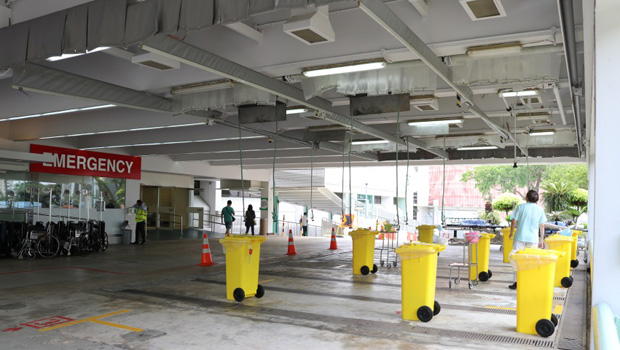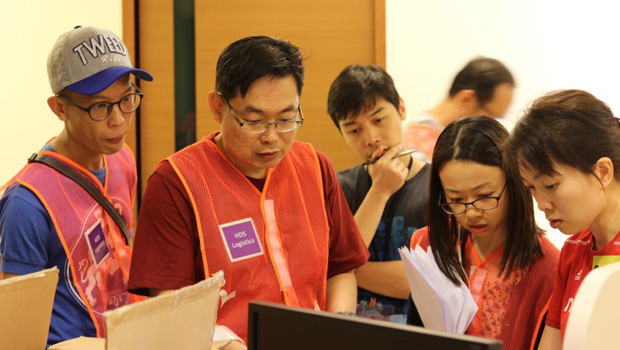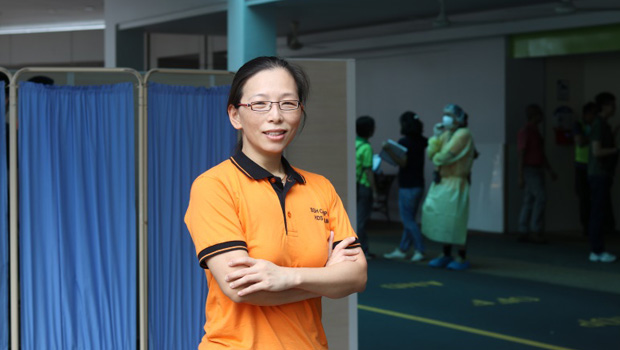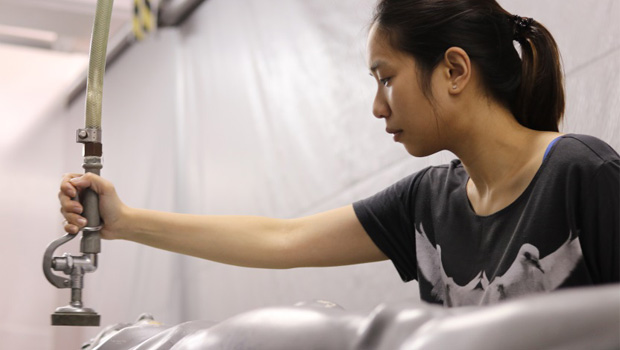Come be a part of the SGH Campus Hospital Decontamination Station team.
A group of office workers was found ‘foaming at the mouth’ and ‘suffering from fits’ in the Central Business District. This scenario of a suspect chemical agent attack was once played out for a Home Team anti-terror exercise.
At the hospital, treatment for such casualties begins with washing off the chemical agent. This process is called decontamination. It ensures that patients, hospital staff, and members of the public will not be at risk of secondary contamination. In SGH, this is carried out by a group of staff specially trained to deploy the SGH Campus Hospital Decontamination Station (HDS), for up to a planned number of 523 casualties.

The SGH Campus Hospital Decontamination Station is located at the A&E porch.
Volunteers not enough
With doctors and nurses focused on providing medical treatment, it is volunteers from other divisions and departments such as Operations, Allied Health, Ambulatory, Human Resource, Finance, Projects and Operations and Performance Management, who will fill various roles within the HDS team. In addition, the SGH Campus institutions also contribute a sizable number of volunteers.
810 is the minimum number we need. As at December 2017, we have 450 volunteers from SGH and SGH Campus institutions, and hope to recruit more.
In the interest of staff safety, volunteers working in the decontamination suit will be deployed for only an hour per shift. Industry experts such as SCDF were consulted on the suits. SOPs are also in place to ensure a structured work-rest cycle so that volunteers can recharge and hydrate at dedicated resting areas before the next shift.
Learn from the veterans
Facilities Development Project Manager Edmund Tan signed up in 2013 when a colleague asked if he would be interested. “I did not quite understand the exact purpose and role then. I only knew it was to save the public from hazardous materials (HAZMAT) exposure.”

Edmund (second from left) in the 10-man HDS logistics team making sure things are in order during Exercise Orca.
The experienced volunteer is very familiar with the operations of the logistics team, which organises things like the decontamination suits and water supply, and takes care of locations for staff to rest. “Over the years, I’ve been able to give suggestions for improvements. I’m also able to combine my skills from Facilities Development to contribute ideas towards our new upcoming HDS facilities,” says Edmund.
Besides logistics, there are roles such as stretcher bearers, de-gowners (strippers), showerers, scanners (for chemical and radiation residual) and re-clothers who dry casualties to prepare them for scanning and dress them.
Therapy Assistant Penny Teh shares that all HDS members are cross trained to do various roles. “This is to prepare everyone for any HDS role during any exercise or situation,” she explains.

Penny challenges the role of stripper in Exercise Orca last September.
In her nearly 10 years of volunteering, Penny is usually assigned the role of chemical agent monitor operator, who scans casualties for residual chemicals. In the latest Exercise Orca in September 2017, she was a stripper. “Our duty as a stripper is to remove all the belongings of the casualties, which also requires us to look out for any weapons on them. We don the decontamination suits, which makes it challenging for us to hold tools such as scissors.”
Amanda Low, Commissioning Secretariat of the SGH Expansion Block, agrees the decontamination suit definitely takes some getting used to. “It’s not easy to put on as it is bulky and the size may not fit well. Many of us felt like we were in a sauna – being in it for a mere 15 minutes causes one to perspire from head to toe! There wasn’t a single moment when I wasn’t perspiring.”

Amanda practises washing and decontaminating a casualty with water and soap. In a real situation, she would be wearing a decontamination suit.
We can all do something
Despite challenges with the decontamination suit designed to protect them, Edmund, Penny and Amanda recognise HDS as an important part of the hospital’s emergency response plan.
For Amanda, an administrator, it is a unique opportunity to contribute directly in the field. “I’m able to help save someone’s life, no matter how minute the act might seem.”
Likewise, Penny feels that in a small country like ours, everyone should play a part in helping out. “The exercises have taught me to sharpen teamwork skills, and we’re more prepared to help in a real disaster. We understand how important HDS support is.”
Edmund feels the same. “Imagine your loved ones being exposed to hazardous materials due to an accident or terrorist incident. In real life, it is not an SGH event but a national disaster. HDS is a vital civil emergency contingency plan. When activated, preparedness and efficiency become crucial. I would encourage as many of us possible to be trained and prepared.”
Would you like to be a HDS volunteer? You have to be from an allied health or non-medical department, healthy, below 60 years old, and you must not be holding other Civil Emergency roles. Please contact Tan Yeong Horng or Lau Ming Yan for more information.
We love mail! Drop us a note at [email protected] to tell us what you like or didn’t like about this story, and what you would like to see more of in LighterNotes.
